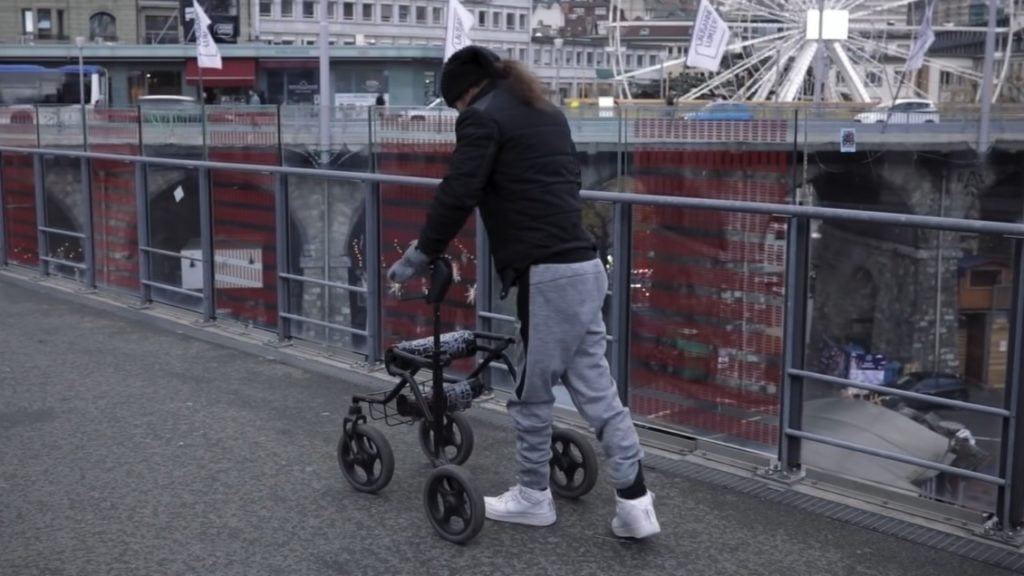
A revolutionary new system that uses electrical spinal stimulation to nerves, simulating the impulses that they normally get from the brain, has restored function in three patients who had been completely unable to move their legs or torso.
Although electrical stimulation therapy has been used for some years now, enabling some paralyzed patients — not all — to walk for limited periods of time, this is the first time scientists have developed a technique that allows for complex movement that uses a method that mimics how the brain constantly interacts with its motor nerves.
Researchers in Switzerland state that their patient is now able to walk and even canoe just as he did before after just five months of rehabilitation.
Now, the researchers say their goal is to make this groundbreaking treatment more accessible to the millions of patients worldwide who are experiencing paralysis.
Spinal stimulation allows patients to walk, stand, paddle a cone and bike soon after injury
As shown in the study, which were published on Monday in the journal Nature Medicine, the new type of system of electrodes restored mobility in three patients who had had complete paralysis of muscles in their legs and torsos.
Astonishingly, the scientists were able to make this happen within one day of treatment, much more quickly than any such stimulation has worked before.
And it had a lasting effect, continuing for months afterward, giving hope that a new corner had been turned in the fight to restore movement in all paralyzed people.
The new therapy differs from more traditional electrical nerve stimulation in that it targets motor nerves that are needed for body movement while older therapies were designed for the treatment of pain and later adapted to try to restore movement.
A co-senior author of the paper, Jocelyne Bloch, a neurosurgeon at Lausanne University Hospital, explains to Scientific American, “The pain electrode arrays are shorter and narrower; they were not designed to specifically target each individual nerve root to activate precisely and specifically the trunk and leg muscles.”
Now, the specific nerves that control movement in the torso and legs have been targeted with the electrical stimulation, even going after particular dorsal roots of the nerves.
Recovery of movement in those with complete spinal cord injury
Grégoire Courtine, the other co-senior author of the new paper, who is a neuroscientist at the Swiss Federal Institute of Technology Lausanne, declared “This is the most precise stimulation of the spinal cord to date and associated recovery of movement in people with complete spinal cord injury.”
The device the team created first targets “dorsal nerve roots,” bundles of nerve fibers that are tasked with delivering sensory information to the spine. However, this sensory input has a direct effect on the motor nerves that are responsible for moving one’s torso and limbs.
Courtine acknowledges that although the effects of his team’s new device are immediate, the patients did require some additional support at first, having to use either two parallel bars alongside them. However, after just one to three more days, they were able to walk again, using a support such as a walker.
After the passage of just a few months, their lives returned to almost normal, showing improvement in the performance of other motor activities, including standing at a bar to have a drink, canoeing, and even bicycling.
Patients still must undergo physical therapy
Part of the groundbreaking insights gleaned in the study are that they now can understand that only a few nerve fibers can survive an accident, and they end up going dormant after receiving no stimulation from nerves from the other parts of the body. Incredibly, their research appears to prove that spinal stimulation just needs to reach these nerve fibers in order to restore them to life.
One wrinkle is that long-term improvements took place only while the patients had their stimulation device on. Those suffering from complete paralysis will therefore need a permanent spinal implant for the treatment to be efficacious.
Naturally, Courtine sees this as a very small price to pay for patients to be able to resume many of their normal daily activities.
V. Reggie Edgerton, a professor of physiology at the UCLA, who is conducting research along similar lines but with external stimulation techniques that do not involve surgery, sees the development as a hopeful one, saying “The [new] evidence is consistent with the possibility that the fine adjustments in the placement of electrodes, relative to the positions of the dorsal roots, could be a factor in resulting in relatively rapid recovery of motor functions.”
Edgerton goes on to say that the new study marks an important advance in the field of helping paralysis patients regain function, but is somewhat skeptical in that he questions how much the “preciseness” in stimulation that was emphasized by the researchers is responsible for the improvements in motor behaviors, since the patients still had to undergo extensive physical therapy sessions.
Bloch and Courtine say that their next field of battle involves expanding access to spinal stimulation therapy in the quest to have paralysis patients regain movement. Their team is working with ONWARD, a collective of scientists, engineers and physicians whose goal os to develop therapies for spinal cord injuries.brain
They plan next to create a commercial version of their spinal stimulation technology and hope to show that it will work once more in another clinical study in 2023. Courtine says he is unsure exactly how much it will cost at the present time but states that it will be similar to other such stimulation technologies for the nervous system, including deep brain stimulation for those suffering from Parkinson’s disease.
Courtine says expansively, “(The idea) is to make this available to everyone.”
See all the latest news from Greece and the world at Greekreporter.com. Contact our newsroom to report an update or send your story, photos and videos. Follow GR on Google News and subscribe here to our daily email!



